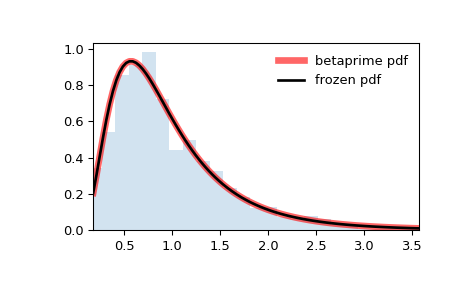scipy.stats.betaprime — SciPy v1.16.0 Manual (original) (raw)
scipy.stats.betaprime = <scipy.stats._continuous_distns.betaprime_gen object>[source]#
A beta prime continuous random variable.
As an instance of the rv_continuous class, betaprime object inherits from it a collection of generic methods (see below for the full list), and completes them with details specific for this particular distribution.
Methods
Notes
The probability density function for betaprime is:
\[f(x, a, b) = \frac{x^{a-1} (1+x)^{-a-b}}{\beta(a, b)}\]
for \(x >= 0\), \(a > 0\), \(b > 0\), where\(\beta(a, b)\) is the beta function (see scipy.special.beta).
betaprime takes a and b as shape parameters.
The distribution is related to the beta distribution as follows: If \(X\) follows a beta distribution with parameters \(a, b\), then \(Y = X/(1-X)\) has a beta prime distribution with parameters \(a, b\) ([1]).
The beta prime distribution is a reparametrized version of the F distribution. The beta prime distribution with shape parametersa and b and scale = s is equivalent to the F distribution with parameters d1 = 2*a, d2 = 2*b and scale = (a/b)*s. For example,
from scipy.stats import betaprime, f x = [1, 2, 5, 10] a = 12 b = 5 betaprime.pdf(x, a, b, scale=2) array([0.00541179, 0.08331299, 0.14669185, 0.03150079]) f.pdf(x, 2a, 2b, scale=(a/b)*2) array([0.00541179, 0.08331299, 0.14669185, 0.03150079])
The probability density above is defined in the “standardized” form. To shift and/or scale the distribution use the loc and scale parameters. Specifically, betaprime.pdf(x, a, b, loc, scale) is identically equivalent to betaprime.pdf(y, a, b) / scale withy = (x - loc) / scale. Note that shifting the location of a distribution does not make it a “noncentral” distribution; noncentral generalizations of some distributions are available in separate classes.
References
Examples
import numpy as np from scipy.stats import betaprime import matplotlib.pyplot as plt fig, ax = plt.subplots(1, 1)
Get the support:
a, b = 5, 6 lb, ub = betaprime.support(a, b)
Calculate the first four moments:
mean, var, skew, kurt = betaprime.stats(a, b, moments='mvsk')
Display the probability density function (pdf):
x = np.linspace(betaprime.ppf(0.01, a, b), ... betaprime.ppf(0.99, a, b), 100) ax.plot(x, betaprime.pdf(x, a, b), ... 'r-', lw=5, alpha=0.6, label='betaprime pdf')
Alternatively, the distribution object can be called (as a function) to fix the shape, location and scale parameters. This returns a “frozen” RV object holding the given parameters fixed.
Freeze the distribution and display the frozen pdf:
rv = betaprime(a, b) ax.plot(x, rv.pdf(x), 'k-', lw=2, label='frozen pdf')
Check accuracy of cdf and ppf:
vals = betaprime.ppf([0.001, 0.5, 0.999], a, b) np.allclose([0.001, 0.5, 0.999], betaprime.cdf(vals, a, b)) True
Generate random numbers:
r = betaprime.rvs(a, b, size=1000)
And compare the histogram:
ax.hist(r, density=True, bins='auto', histtype='stepfilled', alpha=0.2) ax.set_xlim([x[0], x[-1]]) ax.legend(loc='best', frameon=False) plt.show()
